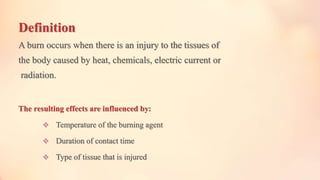Burns can be caused by heat, chemicals, electricity or radiation. The severity depends on temperature, duration of contact and type of tissue injured. Common causes include kitchen accidents, fires, chemicals and electricity. Burns are classified by depth and extent. First degree burns affect the epidermis only, second degree involve the dermis and third degree destroy all skin layers. Burn management involves fluid resuscitation, wound care, infection prevention and rehabilitation. Care includes wound cleaning, debridement, skin grafting and splinting to prevent contractures. Pain management and nutrition are also important aspects of collaborative burn care.




































